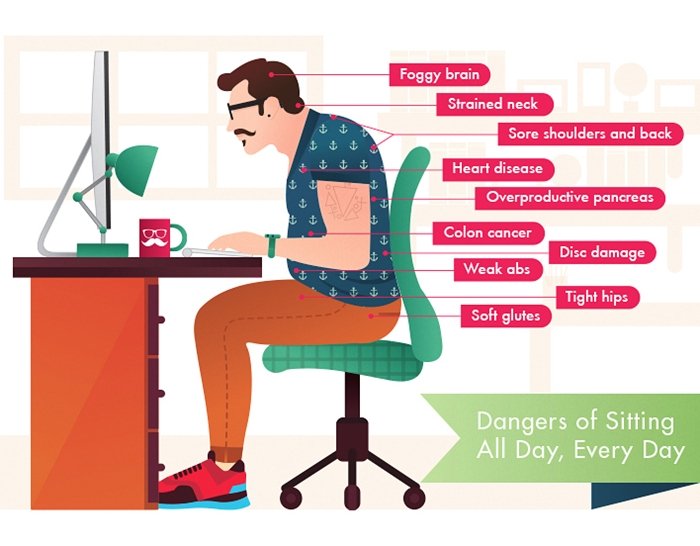
Prolonged periods of sitting in middle age is tied to brain atrophy, new research shows.
Using MRI, investigators found sedentary behavior is a significant predictor of medial temporal lobe (MTL) thinning and its substructures and that physical activity, even at high levels, does not offset the harmful effects of sitting for extended periods.
"The atrophy and anti-neuroplastic processes associated with cognitive decline are thought to begin in the medial temporal lobe. The hippocampal formation and its surrounding structures, specifically, are essential for memory function," lead author, Prabha Siddarth, PhD, a biostatistician at the Semel Institute for Neuroscience and Human Behavior at the University of California Los Angeles (UCLA), told Medscape Medical News.
"It is thought that information is initially collected through the perirhinal and parahippocampal cortices, passes to the entorhinal cortex, and ultimately reaches the hippocampal formation. In addition to funneling information to the hippocampus, the subregions of the parahippocampus are also implicated in some information processing on their own," she added.
"So the finding that sitting reduces the thickness of these important structures is relevant because it suggests that reducing sedentary behavior may be a possible target for interventions designed to improve brain health in middle-aged and older adults."
"It has been said that 'Sitting is the new smoking' in relation to general health," said senior study author, David A Merrill, MD, PhD, assistant clinical professor of psychiatry and biobehavioral sciences in the Division of Geriatric Psychiatry at UCLA.

"These findings show a 'brain effect' of sitting on a critical memory center of the brain. Our hope is that the findings inspire healthy brain habits, at home and work, like taking a 5-minute break to stand up and walk around every 30 to 60 minutes," he said.
The study was published online April 12 in PLOS ONE.
No Offset From Physical Activity
A growing body of evidence suggests physical exercise holds potential for staving off the onset of dementia and Alzheimer's disease (BMC Geriatr. 2015;15:1-7).
In addition, other research shows physical activity benefits both brain macro- and microstructures (J Gerontol A Biol Sci Med Sci. 2014;69:1284-1290; Proc Natl Acad Sci U S A. 2011;108:3017-3022).
However, it's unclear whether there's any relationship between sedentary behavior and dementia risk.
"This is concerning given that sedentary behaviors may be independent from exercise and other physical activities, and therefore warrant independent inquiry," the investigators write. "Indeed, one can be highly active yet still be sedentary for most of the day."
The investigators note that there's very little research examining the impact of sedentary behavior on brain volumes.
To learn more, they enrolled middle-age and older adults without dementia. Study candidates underwent screening that included medical history, a physical exam, and normal global cognition on the Mini-Mental State Examination. After exclusions for depressive or anxiety disorders and age younger than 45 years, 35 individuals were included in the study.
The researchers genotyped patients for APOE4, a genetic risk factor for Alzheimer's disease; 15 participants were carriers.
The 25 women and 10 men in the study each underwent high-resolution MRI to measure the MTL overall and substructure thickness. Patients also completed the International Physical Activity Questionnaire modified for older adults to quantify physical activity and the average number of hours per day spent sitting.
After adjustment for the effects of aging, total MTL thickness was inversely correlated with hours of sitting per day (r = –0.37; P = .03).
While the study revealed a significant association between hours of sitting in a day and total thickness of the MTL (P = .03), there was no significant association between physical activity as a continuous measure (P = .😎 or categorical measure (P = .7) and MTL thickness on MRI.
The investigators also assessed several subregions of the MTL. Thickness was also significantly associated with time spent sitting for the entorhinal cortex (P = .05), the parahippocampal cortex (P = .007), and the subiculum (P = .04). Again, physical activity was not significantly associated with changes to any of these subregions.
Clinical Recommendation
Although the findings are preliminary, Siddarth said it would be worthwhile to ask patients about how much time in the day is spent sitting and encourage them to take activity breaks.
"If they have a desk job that requires sitting in front of a computer for extended periods of time, suggest setting a timer to go off every hour, so they can get up and take a break," she said.
We had hypothesized that both lower levels of physical activity and sitting time will be associated with less thickness in MTL and its subregions. So we were somewhat surprised when we did not find a significant
Congratulations @soorajraja! You have completed some achievement on Steemit and have been rewarded with new badge(s) :
Click on any badge to view your own Board of Honor on SteemitBoard.
For more information about SteemitBoard, click here
If you no longer want to receive notifications, reply to this comment with the word
STOP